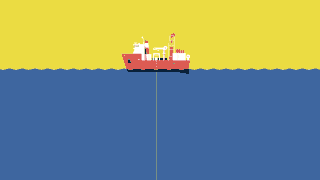Over a year ago, Laurens de Jonge, marine mining manager at Royal IHC, caught a plane for his third flight to Kingston, Jamaica. In the tiny office of a small, relatively unknown intergovernmental body operating under United Nations (UN) mandate, he represented the Netherlands in talks about the future of deep-sea mining. He had been asked to take on that role by the Dutch Ministry of Foreign Affairs. His visit consisted of laying the groundwork for the Mining Code, a set of rules, regulations and procedures to ensure that deep-sea mining, the process of extracting minerals on the seafloor, is well regulated.
It was not the first time that meetings were held to discuss the deep sea. Fierce debates about the future of our international waters have been raging for over 30 years.
All their hard work paid off. A year later, the final deadline is approaching rapidly: until 20 October, scientists, mining companies, government authorities and other stakeholders have one last chance to give their input on the most recent working version of the Mining Code. How? By taking part in a simple, easily accessible review process:
“Name: ...
Government (if applicable): …
Organisation (if applicable): …
General comments: ...
Specific comments: … ”
The standards and guidelines that determine the future of the seafloor below all international waters, which comprises over 40% of the Earth’s surface, are now being wrapped up based on online surveys in response to a few PDF documents.
And then the International Seabed Authority (ISA), the UN-mandated intergovernmental organisation that oversees mineral-related activities on the seabed below international waters, will officially determine who will be allowed to explore where in the upcoming years, and eventually start mining that elusive and mystical place: the deep seabed.
According to experts, there may be more mineral resources at the bottom of the ocean than on all the continents combined. For example, manganese – a metal used in car batteries and lightweight automotive constructions – is 10 times more common in the ocean than on land. The ocean also has four times as much cobalt, and at least twice as much nickel.
Once the ISA arrives at an agreement on the new Mining Code, the door to international waters, or “the common heritage of mankind”, is wide open.
The Mining Code offers an excellent opportunity to create a sustainable, fair-playing field for the mineral riches present in our oceans. But the foundational knowledge used for the code is far too uncertain. We barely know what lives there, and how ecosystems function at these depths – let alone a comprehensive overview of the consequences and risks involved in deep-sea mining.
Even so, we are shortly about to start ploughing the deep seabed, but we don’t know what we’re going to find, nor what we’re going to destroy.
The ocean is full of life and resources
So the ocean is absolutely full of minerals. Lots of minerals. The mining companies are focused on the Clarion-Clipperton Zone (CCZ), situated between Mexico and Hawaii. The CCZ covers 4.5m sq km, making it half the size of the United States.
Some of the minerals in the ocean are created when heated water from hot springs (about 350C/662F) comes into contact with the much colder seawater. When that happens, the chemicals formed during that process, including mineral resources that we can use, precipitate on the ocean floor.
The minerals found in the CCZ originate in a cool state and occur as manganese nodules. These are formed when chemical compounds of iron and manganese adhere to floating grains of sand, or other small particles. Over millions of years, these tiny grains and their accreted compounds grow into a layered nodule of metals such as nickel, copper, manganese and cobalt. These nodules lie scattered across the ocean floor like round cobblestones.
Each and every one contains metals that are crucial to the growing bulk of electronic devices and our global infrastructure.
Take cobalt, for example. At least half of the total global production of this element is in the Democratic Republic of Congo. The country has been struggling for decades with violent conflict and child labour surrounding the mines. And how about the global dependence on China for the bulk of rare-earth elements for use in electronics? Mining for mineral resources in that watery no man’s land would be a perfect alternative for many countries and companies.
Eco-friendly extraction?
Most mining companies will soon have the technology and expertise they need to extract minerals from the deep sea. The Netherlands is a market leader when it comes to deep-sea equipment. The driving force behind that leading position: marine tech company Royal IHC in Rotterdam, where Laurens de Jonge is the manager of marine mining. He is the developer of the Apollo III mining crawler, a seabed mining vehicle that has a surface area of 384 sq metres, which aims to ensure that the minerals, in De Jonge’s own words, “can be harvested quickly and profitably”.
De Jonge’s main motivation here is mining the minerals that really matter most, he explains enthusiastically. In other words, he provides the minerals that the industry and we humans demand most. Not gold, diamonds or silver, but nickel, cobalt, copper and phosphate.
“That’s how it works,” De Jonge says. “And it’s all as eco-friendly as possible.”
“But,” he says, “it’s unavoidable that removing mineral resources will also involve destroying things”.
Deep-sea mining makes quite a commotion
But that’s a fairly serious understatement.
Marine geologist Henko de Stigter is one of the few people on Earth who knows what, to the best of our knowledge, can be achieved in these inhospitable places. But he also knows better than anyone what can be destroyed there. "It’s an extremely vulnerable area, where no human being has ever been,” De Stigter says.
De Stigter previously researched the deep seabed “simply” to understand the foundations of our oceans, but these days he is primarily occupied with mapping out the ecological impacts of deep-sea mining.
The vast majority of deep-sea marine life that is well known, such as sea cucumbers, sponges, corals and cuttlefish, lives in the silt, or is attached to the natural resources themselves. The organisms live off of swirling dust, which also contains nutritious particles. Life down so deep perches precariously on the edge of survival, but the lifeforms are doing just fine for the time being.
Despite the darkness, this place is also a source of life. There are massive mountain ranges, deep ravines and bubbling hot springs. Life here has been able to adapt to harsh living conditions, including the lack of light, intense pressure from the weight of the water column above, and persistent food scarcity.
As soon as you start extracting mineral resources from the landscape, De Stigter says, this could potentially cause a chain reaction of consequences for nature and the environment. The result could be that species may never be able to return to those mining sites: “Maybe millions of years from now, but of course that’s not a realistic timeframe.”
Life in the deep sea also moves at a very different pace than life on land. For example, a deep-sea octopus may spend over four years brooding on her eggs. Some fish, like the orange roughy, live to be almost 200 years old, and sponges can persist to incredible ages, with lifespans reaching thousands of years.
The slower pace can be explained by a slow metabolism, a slow heartbeat, and a slow speed of movement. All related to scarcity of food, and a low ambient temperature. The downside: life in these zones also takes much more time and effort to return compared to life on land once it has been destroyed.
It’s not just the excavation that causes so much destruction. Deep-sea mining makes quite a commotion – and raises a lot of dust.
“In many videos released by mining companies, you can see large chunks of manganese being sucked up calmly in crystal-clear water, but that’s nonsense,” De Stigter says. “This process generates huge clouds of dust, and many animals suffer as a result.”
Why? The density of nutritious particles is instantly and dramatically reduced. “Every edible scrap is now served with a giant bite of indigestible sludge,” De Stigter explains, “and these organisms won’t survive that”.
The deep sea is not a useless, irrelevant void
Still, the question remains: why does that matter? If industry can obtain mineral resources there, and thus “only” disrupt life in these areas, what’s so terrible about that?
Daniëlle de Jonge, marine biologist and PhD researcher at Heriot-Watt University in Edinburgh, is looking at how processes on the deep seabed are related to climate change. According to De Jonge, the deep sea is the exact opposite of useless or irrelevant.
First of all, the deep sea is the largest reservoir of organic carbon on Earth. There is about 50 times more carbon stored there than in our entire atmosphere. That carbon swirls down from the water column above it. Carbon stored in the deep sea will normally remain there for thousands of years. From a human perspective, it therefore disappears “forever” from our ecosystem.
The same applies to nitrogen, another element that isn’t always a welcome addition: at least a quarter of the world’s nitrogen is stored in the ocean on the deep seabed.
Roughly half of the lifeforms that scientists encounter in the deep sea have never been observed before
“Biological processes are essential to maintaining this enormous reservoir in the deep sea,” De Jonge states. “And that’s where deep-sea mining could pose a problem.” Deep-sea biological processes could be affected, since deep-sea mining wipes out the soil community structure. Another consequence: the sediment plume expelled by the mining operations also affects the organisms in the water column above it.
In addition, De Jonge explains, there may be many microbes at the bottom of the ocean that store CO2 in order to stay alive. “That microbial activity will also decrease if the seabed is ploughed up,” De Jonge says.
It may also have consequences for systems higher up in the water column. Phytoplankton colonies living on the surface of the ocean account for about 40% of the CO2 uptake on Earth. If these colonies are overshadowed by silt and excess water, their CO2 uptake also decreases. Exactly how many phytoplankton would be affected is not clear, but we do know this: about 10-20% of the CO2 stored by phytoplankton is transported to the deep sea.
Roughly half of the lifeforms that scientists encounter in the deep sea have never been observed before. “Even if the effects of disrupting these species will not be noticeable to humans for a thousand years, will we be able to forgive ourselves if we allow species to become extinct before we have even discovered them in the first place?,” De Jonge wonders aloud. “Besides the intrinsic value of biodiversity, we are also losing a diverse range of biological substances and genetic material for technological and medical applications.”
Marine geologist Henko de Stigter summarises: “It is very possible that nearly all life in these places may never come back. If this were taking place on land, it would be a serious no-go, but suddenly it’s just fine as long as we don’t have to look at the consequences?”
Uncertainty in exchange for even more uncertainty
So that’s what we do know about life that will be endangered by deep-sea mining. But there’s a lot more we don’t know for sure. Here’s a quote from an opinion piece published in Nature in July 2019: “The deep ocean is so poorly sampled that researchers don’t even know how much might be lost through mining activities.”
The Mining Code, the standards and guidelines that will determine deep-sea activities, is based on two questions: how can damage to nature be prevented during deep-sea mining? And how can we regulate the industry’s high demand for mineral resources?
“If we really wanted to answer these questions properly, huge offices would have to be staffed with countless deep-sea researchers,” Henko de Stigter asserts. “Without that research, we do not have the knowledge needed to substantiate the Mining Code.”
These uncertainties serve as the basis for the Mining Code, and that code is moving towards a final decision as soon as possible.
The mining companies have to come up with an assessment of their own impact
For example, De Stigter says, mining tests have never been conducted in the deep sea that are anywhere near representative in terms of scope and scale. Some testing has been done in labs and on a small scale at sea, but this is by no means representative of the actual mining operation. “So we can’t be sure at this point about the environmental impact of the whole operation.”
Another example where uncertainties have been pushed aside by the craving for minerals comes from the ISA itself. The Clarion-Clipperton Zone has been explored for over 15 years by contractors from prominent industrial nations such as Germany, France and China. The ISA gave these countries a license for exploration. This is done to check whether minerals are present, but the resources are not actually mined in the process.
However, De Stigter notes: according to the ISA’s own rules, the contractors must start actual mining operations within 15 years of exploration, or their rights to the lot will lapse. That doesn’t have to be a problem if the company does not want to mine there. But De Stigter argues that the ISA has effectively added an incentive for these companies to start mining. Fifteen years ago, it was established that mining would take place, even though the environmental impact assessment had not even fully gotten off the ground.
Laurens de Jonge disagrees: “It’s true, you only get a licence if there is an intention to mine, but that is only possible as long as the Mining Code has not yet been completed. Once it’s finished, then either they need to start mining, or the license expires. It’s logical that there would be finite rights associated with a certain area."
The research that would be needed to properly identify the risks of deep-sea mining is far from complete. Due to time pressure, those efforts are now being redirected to the companies themselves. The mining companies have to come up with an assessment of their own impact. “Sure, but companies obviously paint the prettiest picture they can,” De Stigter rebuts. And the requirements these assessments have to meet, and the possible consequences that may need to be taken into account, are not defined anywhere.
According to De Stigter, it is impossible to chart the real effects of deep-sea mining on this basis.
And there is another factor here: there is no guarantee that the minerals will be usable on a large scale. The techniques used to extract metals from manganese nodules have only been tested on a laboratory scale so far, not on an industrial scale. As a marine engineer, Laurens de Jonge is optimistic about that: “The technology will be developed.”
Decide in haste, regret at leisure
The most important problem involved in deep-sea mining, De Stigter says, will become apparent in the long term. We can access minerals now, but what if we find out that the environmental impact 10 years from now will far outweigh the mineral profits? There is no emergency brake. Once a company has a license, it can mine that area for 15 to 30 years. Full stop.
Despite these uncertainties, governments and companies are eager to get started on one of the largest mining operations of all time. Under UN mandate, we are on the verge of destroying something – but we don’t even fully know what it is, or what potential value it could have, now and in the future.
Marine miner De Jonge argues that such devastation is “simply necessary” for a wide range of envisioned applications in electric cars, wind turbines, solar panels and more. He calls it “The Green Dilemma”. “If we really want to make our society ready for green electricity, those minerals are essential, and well, you have to make choices,” he says. “By mining efficiently and intensively, we only affect that piece of nature for a very short time. Large-scale and intensive does not necessarily have to be bad at all.”
Marine geologist De Stigter sees parallels in the search for the coronavirus vaccine: “We want to get on with our lives, and despite all the uncertainties about the efficacy and possible side effects, the whole world is anxiously waiting for a vaccine,” he says. “That’s exactly how it works with mineral resources. It’s urgent. The question is whether deep-sea mining is so extremely urgent that we can take the mountain of uncertainties for granted. I don’t think we should dive blindly into this ambitious venture.”
In the next few weeks and months, I will keep exploring the shadowy world of the dark deep sea, and the mineral resources that are present here. I will continue to investigate the consequences and underlying structures of deep-sea mining. To be continued!
Translated from the Dutch by Joy Phillips.
Dig deeper
 The most important invention of the 20th century keeps us alive but is killing the environment. The solution? Eat less meat
Thanks to an invention in 1909, we now have a world population of almost eight billion people. It keeps half the world’s population alive while wreaking environmental havoc. But we can plant the seeds of positive change by reducing our meat consumption.
The most important invention of the 20th century keeps us alive but is killing the environment. The solution? Eat less meat
Thanks to an invention in 1909, we now have a world population of almost eight billion people. It keeps half the world’s population alive while wreaking environmental havoc. But we can plant the seeds of positive change by reducing our meat consumption.


